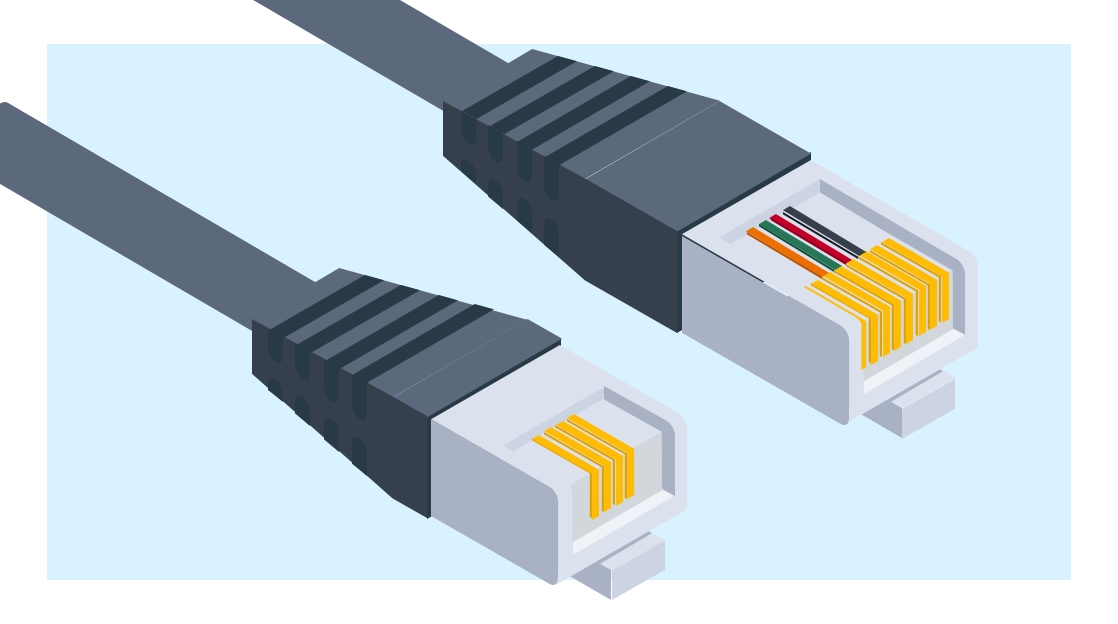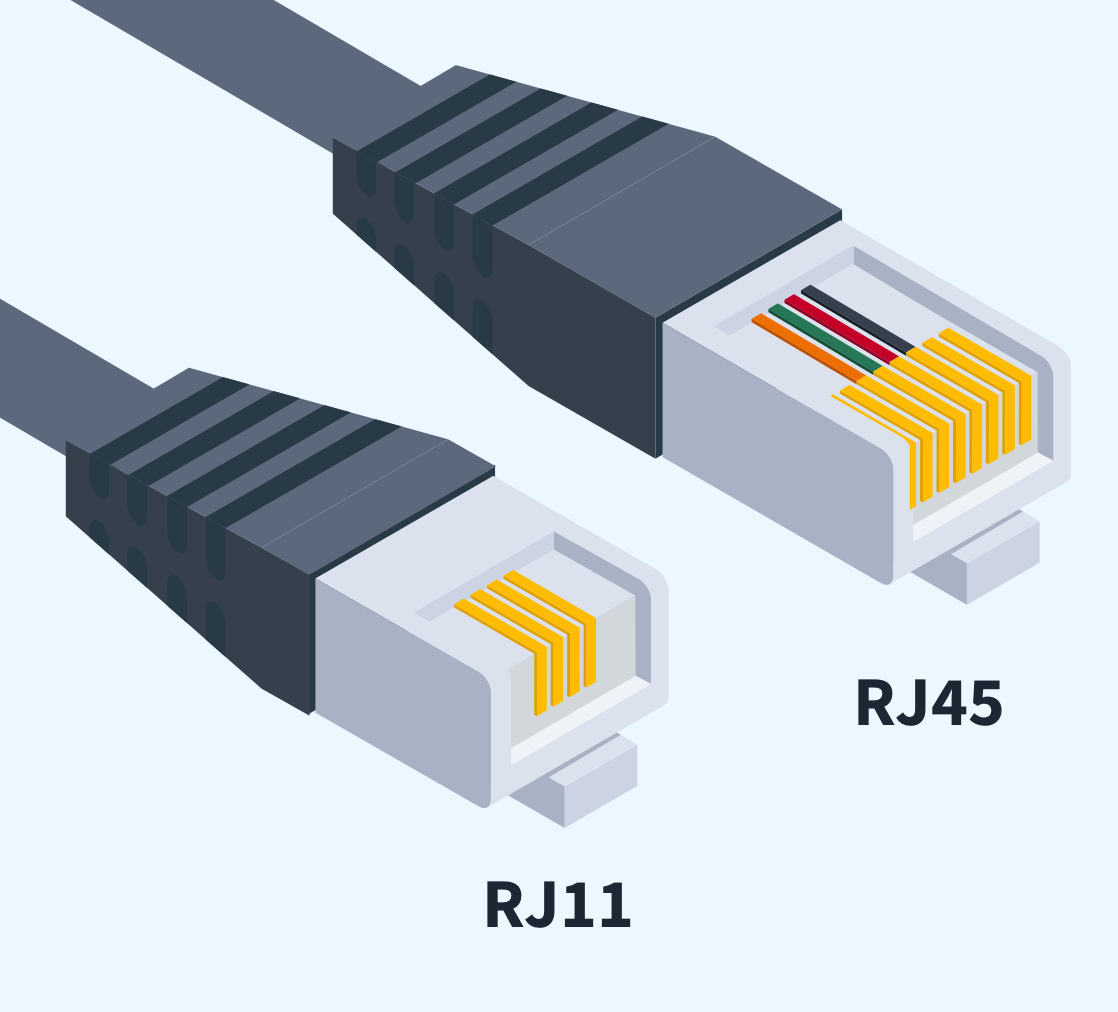RJ11 vs RJ45: What is the Difference?

Quick Definition: RJ11 and RJ45 are both cable connectors, but RJ11 is only capable of transmitting analog data (landline phones, fax machines). In layman's terms, the RJ11 is a telephone jack. RJ45 is meant for digital ethernet traffic and has 8 pins instead of 4, making it larger than its RJ11 predecessor.
Wire connectors differ widely in both design and function. Connectors can look similar yet have vastly different functions. The RJ45 vs RJ11 connectors fit into that category. Without looking closely, you might even assume they are the same.
These connectors appear prominently on the Network+ exam and the CCNA, but they also play a vital role in everyday life. Let’s explore the key difference between RJ11 and RJ45 connectors, and how their functions shape our tech-driven world, starting with the RJ11.
What is an RJ11 Cable Connector?
An RJ11 (Registered Jack-11) is a standardized telecommunication connector used for analog data transmission, typically analog voice signals for landline telephones. If a network is really old, it might also be used on fax machines, scanners, and other network devices. In layman's terms, this is a telephone jack.
What are Analog Voice Signals?
As previously mentioned, the primary purpose of RJ11 connectors is to transmit analog voice signals over a standard telephone line. Analog voice signals are conversions of human speech turned into electrical signals. Analog, as opposed to digital, refers to data representation through continuous waveform outputs rather than binary transmission.
When a person speaks on a telephone, the voice pressure of their speech contacts a sensitive transducer. That device converts their words into unique analog voice signals. It will emulate their speech, pitch, and timbre on the other end of the line. It should be noted that this does not involve binary or digitized data whatsoever. Instead, it is just a continuous wave of analog data.
Can You Run Internet Through a Phone Line?
Yes, you can run the internet through a phone line. In fact, that is how many users first began using the internet! Generally, this is done using a DSL (Digital Subscriber Line) connection, which requires a DSL modem. However, in this day and age, it is an outdated method of delivering high-speed internet.
Today, it is far more common to leverage fiber-optics, cable modem, or WiFi for internet transmission. However, DSL connectivity can still be viable in rural or remote regions.
What is an RJ45 Cable Connector?
An RJ45 cable connector is a standardized telecommunication connector used for digital data transmission, particularly in Ethernet routing. RJ45 connectors are crimped onto Cat5, Cat5e, and Cat6 cables. Then, they are connected to computers, scanners, routers, and switches residing on a LAN.
What are Digital Data Signals?
Digital data signals are signals that are converted into binary ones and zeroes, transmitted over a median such as WiFi or Ethernet. “Ones and zeroes” refers to voltage differentials, not actual ones and zeroes. The voltage encoding is used as instructions by a CPU processor to execute instructions. Typically, a “one” will be around 3.3 volts, and a “zero” will be about 0.4 volts.
Why Would You Use an RJ45 Connector?
RJ45 connectors are used to connect machines to each other on an Ethernet network. RJ45 connectors are crimped onto Cat5, Cat5e, or Cat6 cables; then, these cables are run through a LAN to provide internet and intranet access to a group of machines. In short, you'll use RJ45 connectors to connect to Cat cables for internet access.
How Do RJ11 and RJ45 Work?
RJ11 and RJ45 connectors share a similar appearance and function in a similar way. Each corresponding wire for RJ11 and RJ45 has smaller wires in them that are terminated at the end by their respective RJ connector. RJ11 has 4 wire connectors, while RJ45 has six.
RJ11 and Twisted Copper Wire
Twisted copper wires are terminated with RJ11 connectors. The copper wires are twisted together in a helical fashion to facilitate a concept known as differential signaling. Each copper wire in the helical bundle plays a role in ensuring the fidelity of the signal.
Each wire represents either a “positive” conductor or a “negative” conductor, and fluctuates in opposite directions. The voltage difference is equivalent to the original voice signal, and is used to ensure the signal stays accurate.
RJ45s Have Eight Contacts and Four Pairs
RJ45s have eight contacts and four pairs. Each of the eight contacts will correspond with one of the four color-coded pairs of wires inside the Cat cable. There are a few different wiring standards for RJ45, so it's important to make sure they are crimped correctly.
The copper wire pairs are twisted to reduce electromagnetic interference and other forms of cross-talk. These cables use differential signaling to transmit data as well, but the data is binary in nature.
Main Differences Between RJ11 and RJ45
While RJ11 and RJ45 may look similar, they serve significantly different purposes. Four-pin RJ11 connectors send analog data over twisted copper for telephone lines. RJ45, on the other hand, uses 8 pins to send digital data over copper wire.
The foolproof difference between the two is that RJ45 connectors are about fifty percent bigger than their RJ11 counterpart.
What Devices Need RJ11?
RJ11 connectors are almost exclusively used within the realm of POTS (Plain Old Telephone System). Any analog telephone line will require this connector. If you look hard enough around your house or apartment, you’ll likely see a wall plate for an RJ11 connector—it will be around where the telephone would be.
What Devices need RJ45?
All Ethernet-connected devices need an RJ45 connector. If your house is modern or has been renovated, it will likely have a wall plate with an RJ45 connector where your router would go. Scanners, computers, fax machines, and just about everything that would connect to a modern-day LAN topology would have an RJ45 connector.
Can You Use RJ11 for the Internet?
RJ11 is suitable for low-speed DSL connection in rural or remote areas with existing telephone lines. Bear in mind while this can be done, your connection is unlikely to support watching video or other bandwidth-intensive online activities.
Devices That Use RJ11 or RJ45
Modern-day IT hardware will not have RJ11 connectors, as RJ11 has been relegated to exclusively telephone connections. RJ45, however, is leveraged in every modern-day organization with a LAN or internet connection.
Landline Telephones and Fax Machines Need RJ11
Landline telephones are still commonly used worldwide, so the RJ11 is unlikely to go away. Also, fax machines work fine using RJ11, though many have been digitized for Ethernet compatibility.
Ethernet Networks, LANs, and IP Phones Need RJ45
RJ45 connectors have a far more diverse array of uses. VoIP connections, LANs, and Ethernet all require RJ45 connectors to terminate their cables. Many phones nowadays have an RJ45 connector and are run to a modem. That means the user's voice is digitized and sent as ones and zeros to the recipient, as opposed to analog waveforms.
RJ11 Vs RJ45: Conclusion
We’ve explored the differences between RJ11 vs RJ45 connectors. These connectors are ubiquitous in the modern world and are core components of the Network+ Exam, CCNA, and other network-related certifications.
Remember that the RJ11 is smaller than the RJ45 connector, and is only used for telephones and old fax machines. RJ45 is used for all Ethernet-related connectivity to the internet and intranets. When you hear “Ethernet”, think “RJ45” — they always go together. Next, it might be helpful to understand how these connectors interact with different components on a network. Here are a couple of resources to get you started.
Not a CBT Nuggets subscriber? Sign up for a 7-day free trial.
delivered to your inbox.
By submitting this form you agree to receive marketing emails from CBT Nuggets and that you have read, understood and are able to consent to our privacy policy.
